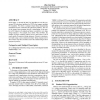62 search results - page 4 / 13 » Revisiting Genetic Algorithms for the FPGA Placement Problem |
DAC
2005
ACM
14 years 8 months ago
2005
ACM
Previous research has shown both theoretically and practically that simulated annealing can greatly benefit from the incorporation of an adaptive range limiting window to control ...
FPGA
2003
ACM
14 years 21 days ago
2003
ACM
In this paper, we present the first exact algorithm to solve the constrained I/O placement problem for FPGAs that support multiple I/O standards. We derive a compact integer line...
AHS
2006
IEEE
14 years 1 months ago
2006
IEEE
Domain-specific reconfigurable arrays have shown to provide an efficient trade-off between flexibility of FPGA and performance of ASIC circuit. Nonetheless, the design of these he...
FPL
2010
Springer
13 years 5 months ago
2010
Springer
One of the more popular placement algorithms for Field Programmable Gate Arrays (FPGAs) is called Simulated Annealing (SA). This algorithm tries to create a good quality placement ...
GECCO
2005
Springer
14 years 1 months ago
2005
Springer
Genetic Algorithms have worked fairly well for the VLSI cell placement problem, albeit with significant run times. Two parallel models for GA are presented for VLSI cell placemen...

